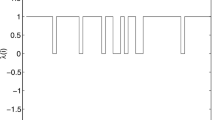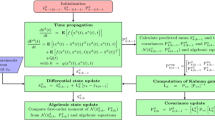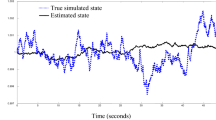Abstract
The stochastic versions of non-linear dynamic circuits are formalized using non-linear stochastic differential equations. Stochastic differential equations (SDEs) are exploited to analyse dynamical systems in noisy environments. A potential application of the SDEs can be regarded as ‘stochastic processes in electronic circuits’. The noisy sampling mixer, a component of digital wireless communications, is an appealing and standard case from the dynamical systems’ viewpoint. It assumes the structure of a non-linear SDE, and its linearized version becomes time-varying bilinear SDE. This paper derives the filtering equations for the noisy non-linear sampling mixer circuit utilizing the filtering density evolution equation. The filtering model for the stochastic problem of concern here comprises the following: (1) a non-linear SDE describing the noisy sampling mixer and (2) a non-linear noisy observation equation. It is interesting to note that the filtered estimate accounts for observations. On the other hand, the predicted estimate does not account for the observation terms in evolution equations. As a result of this, the filtered estimate confirms the greater accuracy of estimated state trajectory in contrast to the predicted trajectory. The filtering equation of this paper can be further utilized for control of the noisy sampling mixer, where the observations are available.







Similar content being viewed by others
References
C. Bruni, D. Dipillo, G. Koch, Bilinear systems: an appealing class of ‘nearly linear systems’ in theory and applications. IEEE Trans. Autom. Control 19, 334–348 (1974)
P. Diaconis, Application of the method of moments in probability and statistics, in Moments in Mathematics, ed. by H.J. Landau. Proceedings of Symposia in Applied Mathematics, American Mathematical Society vol. 37, pp. 125–142 (1987)
P. Hänggi, P. Jung, Colored noise in dynamical systems, in Advances in Chemical Physics, ed. by I. Prigogine, S.A. Rice (Wiley, London, 1995), pp. 239–323
P. Heydari, An analysis of high-frequency noise in RF active CMOS mixers. Analog Integr. Circuits Signal Process. 48, 199–209 (2006)
A.H. Jazwinski, Stochastic Processes and Filtering Theory (Academic Press, New York and London, 1970)
I. Karatzas, S.E. Shreve, Brownian Motion and Stochastic Calculus (Graduate Text in Mathematics) (Springer, New York, 1991)
P.E. Kloeden, E. Platen, The Numerical Solutions of Stochastic Differential Equations (Applications of Mathematics) (Springer, New York, 1991)
J. Lee, V.J. Mathew, A stability condition for certain bilinear systems. IEEE Trans. Signal Process. 42(7), 1871–1873 (1994)
R.S. Liptser, A.N. Shiryaev, Statistics of Random Processes I (Springer, Berlin, 1977)
D. Mumford, The dawning of the age of stochasticity, in Mathematics-Frontiers and Perspectives, ed. by V. Arnold, M. Atiyah, P. Lax, B. Mazur (American Mathematical Society, Providence, RI, 2000), pp. 197–218
H.G. Patel, S.N. Sharma, Some evolution equations for an Ornstein–Uhlenbeck process-driven dynamical system. Fluct. Noise Lett. 11(4), 1250020–1250039 (2012)
N.S. Patil, S.N. Sharma, On the mathematical theory of a time-varying bilinear Stratonovich stochastic differential system and its application to two dynamic circuits. Trans. ISCIE 27(12), 485–492 (2014)
K. Pitt, N. Shephard, Filtering via simulation: auxiliary particle filters. J. Am. Stast. Assoc. 94(446), 590–599 (1999)
V.S. Pugachev, I.N. Sinitsyn, Stochastic Differential Systems (Analysis and Filtering) (Wiley, Chichester and New York, 1987)
M. Schetzen, The Volterra and Wiener Theories of Non-linear Systems (Krieger, Malabar and Florida (USA), 2006)
W.H. Steeb, F. Wilhelm, Non-linear autonomous systems of differential equations and Carleman linearization procedure. J. Math. Anal. Appl. 77(2), 601–611 (1980)
R.L. Stratonovich, Topics in the Theory of Random Noise (vol 1) (Gordon and Breach, New York, 1963)
J.P. Uyemura, CMOS Logic Circuit Des. (Academic, New York, 2002)
W. Yu, S. Sen, H. Leung, Distortion analysis of MOS track-and-hold sampling mixers using time-varying Volterra series. IEEE Trans. Circ. Syst. II 46(2), 101–113 (1999)
W. Yu, H. Leung, Noise analysis for sampling mixers using stochastic differential equations. IEEE Trans. Circ. Syst.-II 46(6), 609–704 (1999)
Acknowledgments
The Authors are grateful to finer and in-depth comments of anonymous qualified Reviewers. Corrections on the lines of the suggestions of the Reviewers and the Editor led to the error-less content of the paper.
Author information
Authors and Affiliations
Corresponding author
Additional information
This work is supported with a CSIR research grant scheme, Engineering Sciences, New Delhi, India, CSIR, No. 22(0679)/14/EMR-II.
Appendix
Appendix
From the system-theoretic viewpoint, Eq. (4) of the paper, which is stated as Eq. (7) of Yu and Leung [20], is regarded as a time-varying scalar ‘bilinear’ stochastic differential system. Consider a structure of a bilinear time-varying stochastic differential equation,
where \(B_t\) is the Brownian motion process, a stochastic process. The parameter vector \(\left( {\mu _{t,} \alpha _t ,\beta _t ,\gamma _t } \right) ^{T}\) of the above stochastic differential equation is time varying, and the term \(\gamma _t x_t \hbox {d}B_t \) denotes the input-state time-varying coupling term. The input-state coupling term leads to the notion of bilinearity, see the last term of Eq. (4). The bilinear system is a nearly linear system yet non-linear system (Bruni et al. [1]). Bilinear systems have found applications in population models, communications, echo cancellations, electrical circuits and electronic circuits under noise influence. Bilinear systems make a connection to the Volterra theory (Schetzen [15]), see Lee and Mathew [8] as well. Here, the Authors explain briefly a time-varying Itô bilinear stochastic differential equation as well as Itô bilinear stochastic differential equation with constant coefficients.
A sampling mixer time-varying Itô bilinear SDE is
The closed-form solution to the above SDE can be obtained using the solution stated in Pugachev and Sinitsyn ([14], pp. 181–182).
Thus
From Eqs. (25) and (26), we get
For constant coefficients, Eq. (26) becomes
The term within the last integral sign of the right-hand side of the above can be further simplified using stochastic differential rule, i.e.
From Eq. (27) in combination with (28), we get
For the simplified analysis, consider \(B_{t_0} =0\) and \(t_0 =0\), we have
After taking the action of conditional expectation operator, we get
The conditional mean trajectory \(\langle {x_t}\rangle \) would be bounded for \(\alpha <0\). At \(\alpha <0\), the mean trajectory \(\left\langle {x_t } \right\rangle =\left\langle {x_0 } \right\rangle \exp (\alpha t)\) would be bounded. Equation (30) is quite general that will be useful for the noise analysis of scalar bilinear stochastic differential systems arising from diverse fields, e.g. noisy non-linear electronic circuits.
Another important point to worth mention is that the power spectral density \(S_{xx} (\omega )=S_{v_\mathrm{d} v_\mathrm{d} } (\omega )\) of the output process can be obtained by exploiting Eq. (29) and the relation
Note that the notations \(\mathfrak {I}\) and \(\langle \,\rangle \) denote the Fourier transform operator and the expectation operator, respectively. The notation \(R_{v_\mathrm{d} v_\mathrm{d} } (\tau )\) denotes the autocorrelation of a wide-sense stationary output process. The sampling mixer SDE of this paper, Eq. (3), is non-linear and time varying; the closed-form solution to the output drain voltage \(v_\mathrm{d}\) in terms of the gate noise \(\xi _t\) is not possible. Thus, the closed-form expression for the power spectral density \(S_{v_\mathrm{d} v_\mathrm{d} } (\omega )=\mathfrak {I}R_{v_\mathrm{d} v_\mathrm{d} } (\tau )=\mathfrak {I}\left\langle {v_\mathrm{d} (t+\tau )v_\mathrm{d} (t)} \right\rangle \) is intractable.
Rights and permissions
About this article
Cite this article
Gawalwad, B.G., Sharma, S.N. On a Non-linear Electronic Circuit Filtering. Circuits Syst Signal Process 35, 459–480 (2016). https://doi.org/10.1007/s00034-015-0070-0
Received:
Revised:
Accepted:
Published:
Issue Date:
DOI: https://doi.org/10.1007/s00034-015-0070-0




